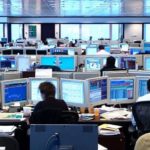If you saw a penny on the sidewalk, would you pick it up? You may think it’s not worth the effort, but a breed of investors who have been in the news do. Using high-speed, high-frequency programmed trades, Traders in effect bend down to pick up those pennies – often millions lying around in the stock market – then do it again, sometimes thousands of times a second. There is nothing wrong with this activity in, and of itself, however, HFTs have become a matter of financial public policy and regulatory review given a glimpse into its potential harm to efficient Markets. Left un-checked this could become the next big financial disaster waiting to happen.
 More than a week after the Dow Jones industrial average fell nearly 1,000 points, its biggest intraday drop ever, regulators are still sifting through buy and sell orders to figure out what sparked it. As some may recall, in the wake of the so-called ‘Flash Crash’ two week ago, I had raised doubts about the official narrative – human error – being attributed as its cause. One big focus are orders placed by high-frequency traders, or HFTs, and for good reason. These quick-buck firms barely existed a few years ago but now account for two-thirds of all U.S. stock trading volume. In other words, all those TV pictures of the stately New York Stock Exchange building on the evening news are an illusion. The real action on Wall Street is far away in Kansas City, Mo., and in New Jersey, in towns like Carteret and Red Bank, where HFTs named Tradebot and Wolverine and Tradeworx ply their trade.
More than a week after the Dow Jones industrial average fell nearly 1,000 points, its biggest intraday drop ever, regulators are still sifting through buy and sell orders to figure out what sparked it. As some may recall, in the wake of the so-called ‘Flash Crash’ two week ago, I had raised doubts about the official narrative – human error – being attributed as its cause. One big focus are orders placed by high-frequency traders, or HFTs, and for good reason. These quick-buck firms barely existed a few years ago but now account for two-thirds of all U.S. stock trading volume. In other words, all those TV pictures of the stately New York Stock Exchange building on the evening news are an illusion. The real action on Wall Street is far away in Kansas City, Mo., and in New Jersey, in towns like Carteret and Red Bank, where HFTs named Tradebot and Wolverine and Tradeworx ply their trade.
High-frequency trading firms, which number over 100, use computers programmed with complex mathematical formulas to comb markets for arbitrage opportunities – securities priced too high or too low because traders haven’t had to time to react to the latest data. The computers then buy or sell in a split second, locking in the profit. But HFTs are not limited to U.S. Markets; they have also proliferated in global markets, thus carrying the potential to wreak havoc on the global financial infrastructure. As such, clearly, this also raises concerns for global financial regulators.
The opportunities seem hardly worth noting. They’re not just fleeting, but small, often a penny or less. But those pennies can add up to a lot of money, enough to draw the attention of Goldman Sachs Group Inc., the giant Chicago hedge fund Citadel Investment and other big financial firms. In recent years they’ve paid hundreds of millions of dollars for stakes in high-frequency trading companies. This money has stoked what was already fierce competition among the firms for a leg up, as this trading strategy proves profitable – almost like ‘free money.’
To spot opportunities and act on them before others, HFTs are constantly hunting for faster computers. They also locate themselves close to the big exchanges’ data centers. That can cut their trade times by milliseconds. This, as we can all see from the Flash Crash phenomena, can drive erratic, highly volatile Market swings if left unchecked. You heard it here first folks.
Read more here.